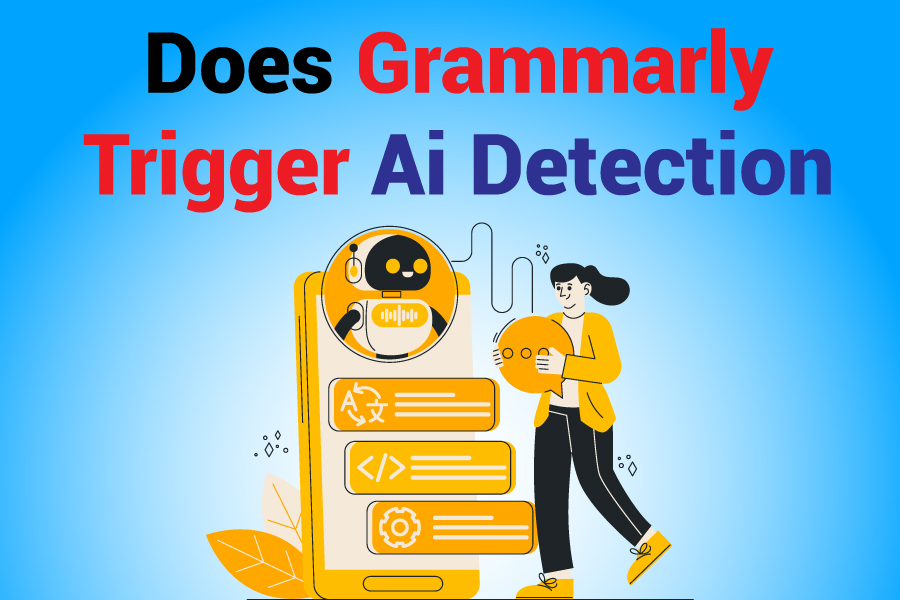In today’s digital age, tools like Grammarly have become indispensable for writers, students, and professionals alike. Grammarly helps improve grammar, spelling, and overall writing quality, making it a popular choice for anyone looking to polish their work. However, with the rise of AI detection systems designed to identify content generated by artificial intelligence, a pressing question arises: Does Grammarly trigger AI detection? Understanding this issue is crucial, especially for those who rely on Grammarly to ensure their writing is top-notch while remaining authentic. In this article, we will delve into how Grammarly works, its potential to trigger AI detection systems, and what you can do to ensure your content stays undetected by AI flags.
Does Grammarly Trigger AI Detection?
Yes, Grammarly can influence AI detection systems. While Grammarly itself is not an AI content generator, its extensive use of algorithms to improve text may cause AI detection systems to flag your content. This happens because AI detectors look for patterns and stylistic changes that could indicate non-human assistance, and Grammarly’s adjustments might sometimes fall into those patterns. However, proper use and moderation can minimize this risk.
How Does Grammarly Work And Its Impact On AI Detection Systems
Grammarly operates by utilizing advanced algorithms to scan text for grammatical errors, spelling mistakes, and stylistic issues. These algorithms compare the text against a vast database of language patterns and rules, suggesting corrections and improvements. The key to understanding whether Grammarly triggers AI detection lies in how these corrections are made. Grammarly’s adjustments often involve complex changes in sentence structure, vocabulary enhancement, and punctuation accuracy. These changes, although beneficial for human readers, might be flagged by AI detection systems designed to identify non-human writing patterns.
AI detection systems work by analyzing text for consistency, originality, and patterns that might indicate AI-generated content. When Grammarly makes extensive changes to a document, it can introduce patterns that AI detectors recognize as non-human. For example, sudden shifts in writing style or vocabulary can be red flags for AI detection algorithms. As a result, even though Grammarly is not generating content, its corrections can make human-written content appear suspicious to AI detectors.
It’s important to note that not all AI detection systems will flag Grammarly-corrected content. The sensitivity and sophistication of these systems vary, and some may be more adept at distinguishing between human edits and AI generation. However, the risk remains, especially with highly sensitive detection systems used in academic and professional settings.
To mitigate the risk of triggering AI detection, users can take several precautions. Firstly, understanding the extent of Grammarly’s changes is crucial. Users should review and manually adjust suggested corrections to ensure the text maintains a natural flow. Secondly, balancing Grammarly’s recommendations with a personal writing style can help reduce detectable patterns. Lastly, using Grammarly as a guide rather than a crutch ensures that the final content retains a human touch.
Breaking Down The Impact Of Grammarly On AI Detection Systems
1. Understanding Grammarly’s Algorithm
Grammarly’s algorithm is designed to improve text quality by identifying and correcting errors. It uses natural language processing (NLP) to understand context and make appropriate suggestions. This sophisticated system, while helpful, can sometimes mimic AI-generated patterns, leading to potential detection issues.
2. AI Detection Systems Identify Non-Human Writing
AI detection systems analyze various text attributes to identify non-human writing. They look for consistency, originality, and stylistic patterns. When Grammarly introduces significant changes, these systems might detect anomalies that flag the content as AI-influenced.
3. The Risk of Over-Reliance on Grammarly
Over-reliance on Grammarly can lead to excessive changes in text, increasing the likelihood of triggering AI detection. Balancing Grammarly’s suggestions with personal writing style is crucial to maintaining the authenticity of the content.
4. Strategies to Mitigate AI Detection Risks
To reduce the risk of AI detection, users should manually review Grammarly’s suggestions, ensure the text maintains a natural flow, and incorporate personal stylistic elements. Using Grammarly as a guide rather than a final authority helps preserve the human touch in writing.
Key Points To Consider With Grammarly And AI Detection
Grammarly’s Algorithm and AI Detection: Grammarly uses advanced algorithms to correct grammar, spelling, and style in writing. These algorithms can sometimes introduce patterns that AI detection systems, designed to identify AI-generated content, might flag as suspicious.
AI Detection Systems’ Mechanisms: AI detection systems analyze text for consistency, originality, and stylistic patterns. Sudden shifts in writing style or vocabulary, which can occur when Grammarly makes extensive corrections, might be flagged by these systems.
The Risk of Over-Reliance on Grammarly: Relying heavily on Grammarly for extensive text modifications increases the risk of triggering AI detection. This is because substantial changes can create detectable patterns that resemble AI-generated content.
Maintaining a Natural Writing Style: To avoid triggering AI detection, it’s essential to manually review Grammarly’s suggestions. Ensuring that the text maintains a natural flow and incorporating a personal writing style can help reduce detectable patterns.
Balancing Automated Corrections with Personal Input: Using Grammarly as a guide rather than a final authority ensures that the content retains a human touch. Balancing automated corrections with personal input helps maintain authenticity and reduces the likelihood of AI detection.
Understanding Grammarly’s Impact: Being aware of how Grammarly’s algorithms work and their potential impact on AI detection systems is crucial. This understanding helps users make informed decisions about how to apply Grammarly’s suggestions effectively.
Evolving AI Detection Technologies: AI detection systems are continuously evolving. As these systems become more sophisticated, they may better distinguish between human edits and AI-generated content, potentially reducing the risk of Grammarly-triggered flags in the future.
Strategic Use of Grammarly: Employing Grammarly strategically by making moderate use of its suggestions and ensuring a balance with personal writing style can help maintain the integrity of the content and avoid AI detection.
Proactive Measures: Taking proactive measures, such as regularly updating knowledge on AI detection systems and Grammarly’s functionalities, can help users stay ahead of potential issues and ensure their content remains authentic and credible.
Review and Adaptation: Regularly reviewing and adapting the approach to using Grammarly ensures that users can leverage its strengths while minimizing the risks associated with AI detection. This continuous learning and adaptation are key to successful and credible writing.
Alternative Perspectives On Grammarly And AI Detection
While Grammarly’s potential to trigger AI detection is a concern, some experts argue that the benefits outweigh the risks. Grammarly provides significant improvements in writing quality, which can enhance readability and credibility. For students and professionals, the tool offers a competitive edge by ensuring error-free content.
Additionally, AI detection systems are constantly evolving. As these systems become more sophisticated, they may better distinguish between human editing and AI-generated content. This evolution could reduce the risk of Grammarly-triggered flags in the future.
Furthermore, using Grammarly responsibly involves a combination of its automated suggestions and personal input. This balanced approach not only improves writing quality but also maintains the authenticity required to pass AI detection systems. Ultimately, understanding how to leverage Grammarly’s strengths while minimizing its risks is key to successful and credible writing.
Conclusion
Grammarly is a powerful tool for improving writing quality, but its extensive use of algorithms can sometimes trigger AI detection systems. By understanding how Grammarly works and taking proactive steps to maintain a natural writing style, users can enjoy the benefits of this tool without compromising the authenticity of their content. Balancing automated suggestions with personal input is key to achieving this goal.
FAQ’s
Can Grammarly Make My Writing Look Like It Was Generated By AI?
Yes, extensive changes made by Grammarly can sometimes introduce patterns that AI detection systems might flag as non-human.
How Can I Avoid Triggering AI Detection While Using Grammarly?
Manually reviewing and adjusting Grammarly’s suggestions, maintaining a natural flow, and balancing automated corrections with personal input can help avoid triggering AI detection.
Does Grammarly Generate Content Like An AI?
No, Grammarly does not generate content. It improves existing text by correcting errors and enhancing readability.
Are All AI Detection Systems Sensitive To Grammarly’s Changes?
Not all AI detection systems will flag Grammarly-corrected content. The sensitivity of these systems varies, with some being more adept at distinguishing human edits from AI generation.
What Should I Do If My Grammarly-Corrected Content Gets Flagged By An AI Detection System?
Review the flagged content, make necessary adjustments to maintain a natural writing style, and consider balancing Grammarly’s suggestions with your input to avoid future issues.












































Leave a Reply